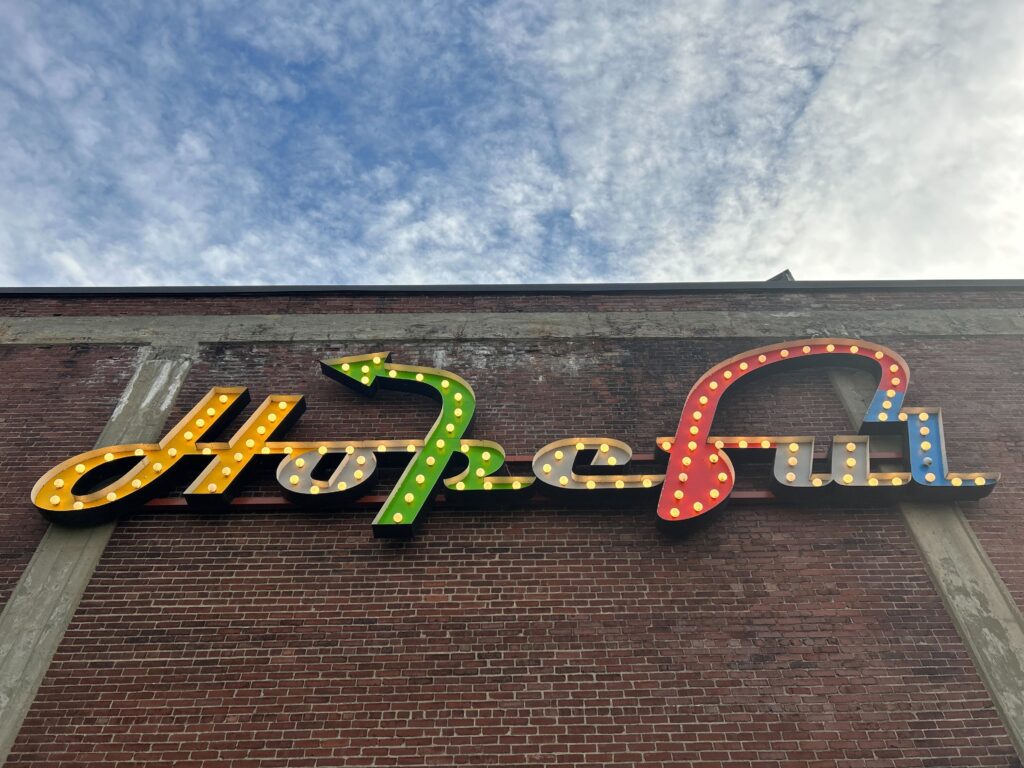The iconic Lewiston Hopeful sign by artist Charlie Hewitt. (Photo by Maine Morning Star)
It’s a wild and painful exercise to mentally revisit the events that took place one year ago tonight.
Some of us remotely observed the horrific events of Oct. 25, 2023, play out in real time with each update, as the full scale of the mass shooting became apparent.
Others woke up to a strange new world of fear and uncertainty, knowing someone armed and dangerous was still on the loose. Residents of Lewiston were confined to their homes. Each of those 48 hours dragged by as we all wondered when the shooter, Robert Card II, would be found, and what would happen next.
And for those who happened to be bowling at Just in Time Recreation or having a drink with friends at Schemengees, or the dozens of families and hundreds of others who know someone that was, time hasn’t been the same since.
Over the past year, significant efforts have gone into understanding what led to the events that day, and steps have been taken to ensure such a failure of oversight and judgment never happens again. As several of Lewiston’s legislative leaders shared with Maine Morning Star, many are still pushing for more.
Survivors and family members of those killed are pursuing a lawsuit against the U.S. Department of Defense and Army for negligence in failing to respond to warning signs about Card’s deteriorating mental health.
Arthur Bernard, whose son Arthur Strout was among the 18 people killed, is cosponsoring a citizen initiative for the state to pass a red flag law, or extreme risk protection order, after the Maine Legislature failed to go so far in its reform efforts.
One year out, healing and justice for the people touched by the shooting are still underway.
In many ways, the state as a whole is still reeling from that collective traumatic experience that shattered Mainers’ sense of security and peace.
Stephanie Cinque, a mental health therapist who founded the Resiliency Center of Newtown after the Sandy Hook Elementary shooting rocked her hometown, has spent the years since consulting with communities that also experienced a mass tragedy.
She has written about how in response to instances of community violence, people may experience loss in their sense of safety and an erosion of trust in their community and government. To heal as individuals and collectively, she said that communities should focus on restoring connections with and between people.
“Recovery from tragedy and building resilience involves acknowledging emotions, seeking support, and taking gradual steps forward,” Cinque writes. “Community connections are pivotal to easing pain and promoting empathy, while collaborating with others to address challenges. Shared activities, support networks, and a focus on a common goal can strengthen community bonds and promote healing.”
However, as the people of Maine come together to mark this terrible anniversary, I can’t help but notice how the blue hearts and “one Lewiston” signs have largely been replaced by campaign signs with neighbors pledging allegiance to opposing teams.
Standing like angry sentries, these candidate signs have come to represent the deep fracture seen in our communities and country.
There seems to be a universal sense of dread and exhaustion about the upcoming national election. But when you listen to people’s concerns, it’s clear that most, regardless of political affiliation, are worried about the state of the world and fearful of the future. Folks just clearly disagree on the path forward.
Just as Cinque emphasizes the importance of community connections, experts also say the key to repairing our growing partisan rift is through individual acts of community engagement.
Ruth Conniff, editor of our sister site Wisconsin Examiner, recently attended a talk given by political scientist Ray Block, the inaugural Michael D. Rich Distinguished Chair for Countering Truth Decay at the Rand Corporation.
Block argued that the antidote to “the bitter polarization and the sheer wackiness of our new political reality,” as Conniff put it, is “a matter of rebuilding individual relationships among neighbors.”
In essence, it’s the same prescription for healing from a collective traumatic event as for moving beyond a deeply partisan rift.
It doesn’t feel particularly neighborly out there these days. But in a few weeks time, the election will be behind us (we hope), and we will still be here living side by side. And if we have any hope of tackling the challenges ahead of us, it needs to be approached on the local level.
As Mainers come together today to honor those lives lost in the horrific violence of Oct. 25, 2023, my hope is that people can take a moment to feel that collective grief and love, and carry that forward with a renewed sense of compassion and community.
Because whatever the outcome of the election, that’s the only way we heal.
YOU MAKE OUR WORK POSSIBLE.

